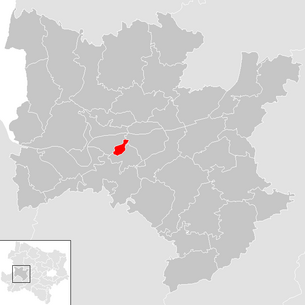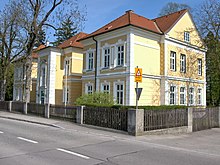Golling on the Erlauf
|
market community Golling on the Erlauf
|
||
|---|---|---|
| coat of arms | Austria map | |
|
|
||
| Basic data | ||
| Country: | Austria | |
| State : | Lower Austria | |
| Political District : | Melk | |
| License plate : | ME | |
| Main town : | Neuda | |
| Surface: | 2.71 km² | |
| Coordinates : | 48 ° 12 ' N , 15 ° 11' E | |
| Height : | 215 m above sea level A. | |
| Residents : | 1,510 (January 1, 2020) | |
| Population density : | 557 inhabitants per km² | |
| Postal code : | 3381 | |
| Area code : | 02757 | |
| Community code : | 3 15 09 | |
| NUTS region | AT121 | |
| UN / LOCODE | AT GAE | |
| Address of the municipal administration: |
Rathausplatz 1 3381 Golling an der Erlauf |
|
| Website: | ||
| politics | ||
| Mayoress : | Gabriele Kaufmann ( SPÖ ) | |
|
Municipal Council : ( 2020 ) (19 members) |
||
| Location of Golling an der Erlauf in the Melk district | ||
 Municipal Office |
||
| Source: Municipal data from Statistics Austria | ||
Golling an der Erlauf is a market town with 1510 inhabitants (as of January 1, 2020) in the Melk district in Lower Austria .
geography
Golling an der Erlauf is located in the valley of the Erlauf around 5 km before it flows into the Danube in the Mostviertel in Lower Austria. The area of the market town covers 2.71 square kilometers. 34.12 percent of the area is forested.
Community structure
The municipality includes the following four localities (population in brackets as of January 1, 2020):
- Golling (671)
- Hinterleiten (128)
- Neuda (689)
- Sittenberg (22)
The community consists of the cadastral community Golling.
Neighboring communities
history
In ancient times, the area was part of the Noricum province .
The place was previously known as Goldarn, as gold was found in the Erlauf in the past. The part of Golling called Sittenberg was most likely inhabited earlier by a nobleman or knight, from whom the name comes.
Population development
According to the results of the 2001 census , there were 1699 inhabitants. In 1991 the market town had 1614 inhabitants, in 1981 it had 1632 and in 1971 it had 1620 inhabitants.
Culture and sights
- Municipal office: The municipal office of Golling an der Erlauf, built between 1923 and 1925, was designed by the Viennese architect Anton Valentin .
- Catholic parish church Golling an der Erlauf hl. Francis
Economy and Infrastructure
In 2001 there were 38 non-agricultural workplaces, and according to the 1999 survey there were six in agriculture and forestry. The number of people in work at home was 704 according to the 2001 census. The 2001 employment rate was 42.14 percent.
- At the moment Golling's economy is on the up again, as after a long, arduous search a buyer for the old Hitiag and Neudagarn factories has been found. Since the renovation of the area, it has been named after the investor “Aigner Business Park”.
politics
The municipal council has 19 members.
- With the municipal council elections in Lower Austria in 1990, the municipal council had the following distribution: 16 SPÖ and 3 ÖVP.
- With the municipal council elections in Lower Austria in 1995, the municipal council had the following distribution: 15 SPÖ, 2 ÖVP and 2 FPÖ.
- With the municipal council elections in Lower Austria in 2000, the municipal council had the following distribution: 16 SPÖ, 1 FPÖ and 1 ÖVP.
- With the municipal council elections in Lower Austria in 2005 , the municipal council had the following distribution: 16 SPÖ, 2 ÖVP and 1 FPÖ.
- With the municipal council elections in Lower Austria 2010 , the municipal council had the following distribution: 14 SPÖ, 3 FPÖ and 2 ÖVP.
- With the municipal council elections in Lower Austria in 2015 , the municipal council had the following distribution: 14 SPÖ, 3 FPÖ and 2 ÖVP.
- With the municipal council elections in Lower Austria 2020 , the municipal council has the following distribution: 13 SPÖ, 3 ÖVP, 2 FPÖ and 1 GM-Gollinger Mitte.
mayor
- until 2011 Theodor Fischer (SPÖ)
- since 2011 Gabriele Kaufmann (SPÖ)
Personalities
- Lukas Viehberger (* 2000), cyclist
Web links
- Golling an der Erlauf website
- 31509 - Golling on the Erlauf. Community data, Statistics Austria .
Individual evidence
- ↑ Mayor's office of Golling an der Erlauf (accessed on April 12, 2011)
- ↑ Statistics Austria: Population on January 1st, 2020 by locality (area status on January 1st, 2020) , ( CSV )
- ^ Anton Valentin. In: Architects Lexicon Vienna 1770–1945. Published by the Architekturzentrum Wien . Vienna 2007.
- ^ Result of the local council election 1995 in Golling an der Erlauf. Office of the Lower Austrian State Government, March 30, 2000, accessed on October 28, 2019 .
- ^ Election result of the municipal council election 2000 in Golling an der Erlauf. Office of the Lower Austrian State Government, February 4, 2005, accessed on October 28, 2019 .
- ^ Election result of the municipal council election 2005 in Golling an der Erlauf. Office of the Lower Austrian State Government, March 4, 2005, accessed on October 28, 2019 .
- ^ Election result of the municipal council election 2010 in Golling an der Erlauf. Office of the Lower Austrian State Government, October 8, 2010, accessed on October 28, 2019 .
- ^ Election results for the 2015 municipal council election in Golling an der Erlauf. Office of the Lower Austrian State Government, December 1, 2015, accessed on October 28, 2019 .
- ↑ Results of the municipal council election 2020 in Golling an der Erlauf. Office of the Lower Austrian State Government, January 26, 2020, accessed on June 10, 2020 .








